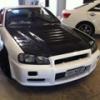Jaycar Boost and Fuel Control
Announcements
-
Similar Content
-
Latest Posts
-
R31 boot how I received the sub, cleaned and today new carpet installed. Thank you Solder!!!!
-
By Murray_Calavera · Posted
@joshuaho96 Hmm considering the drama you've seen/experienced, have you looked into getting a built complete long motor shipped from Australia? Considering the AUD is basically monopoly money when compared to the USD, at a glance this seems like a good option? -
Bloody Skylines, they put you through the bloody wringer! Stick at it! Stunning drag strip BTW! Where is it? Can see part of the name on the slip and probably should just Google it!
-
By joshuaho96 · Posted
I mean the other day I had to walk someone through diagnosing why their timing belt was walking off the cam gears. At least one of the issues was a bent tensioner stud. Local mechanics have found runout on the CAS mechanism causing weird failures. I'm also no saint here I've documented some of the things I've had to learn the hard way. Something I discovered recently is that my CA emissions catalytic converters weren't even welded correctly to align the downpipe to the main cat and they tossed the support bracket that goes from the transfer case to the downpipe to support everything there. I spend a lot of time chasing down these decidedly unsexy problems and the net effect is it feels like I never actually get to the original objective (flex fuel, VCAM, oil control, cooling, etc). -
At times with how you make everything sound, all I imagine Americans doing when they see a gtr is standing there looking at it and bashing it with a gun like how a caveman would with a club and hoping it fixes itself
-





Recommended Posts
Create an account or sign in to comment
You need to be a member in order to leave a comment
Create an account
Sign up for a new account in our community. It's easy!
Register a new accountSign in
Already have an account? Sign in here.
Sign In Now